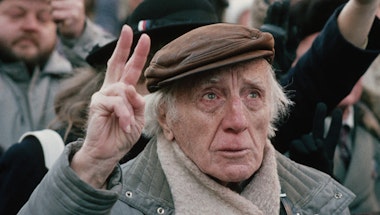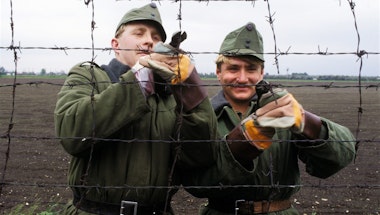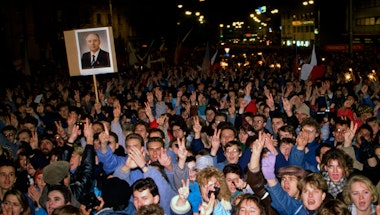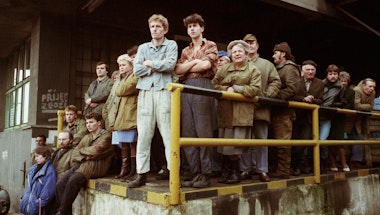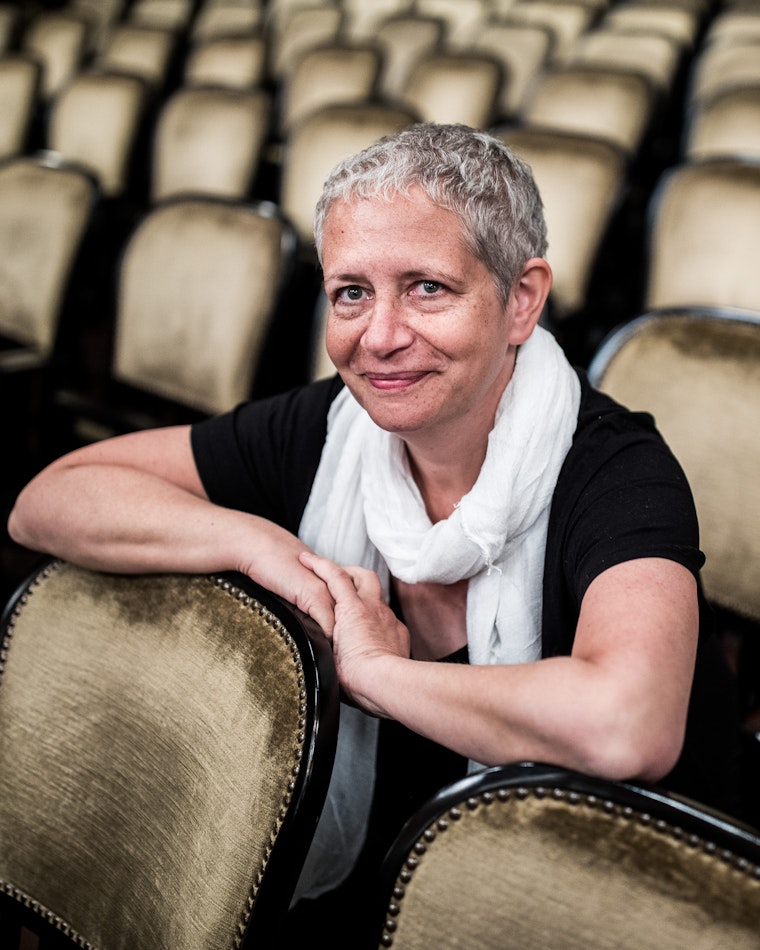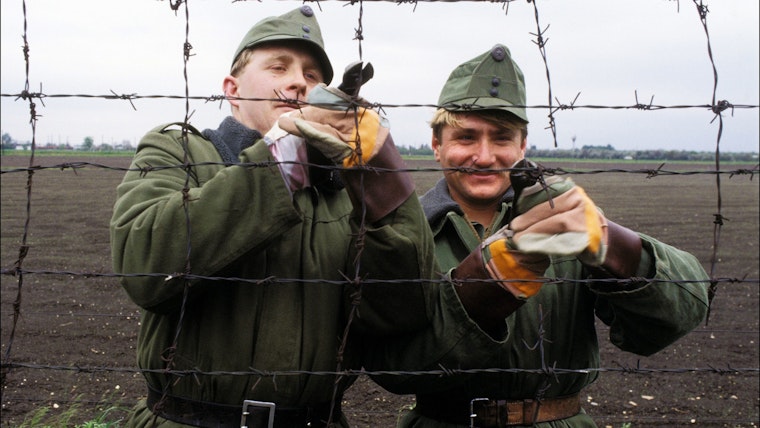
Hungary
In the 1980s, Hungary’s Communist party was the most reform-minded party in the Eastern Bloc. While maintaining a firm grip on political life, it even sought investment from the West as a way to address the country’s mounting economic problems. The limited opening included allowing George Soros to establish his first local foundation in the country, in 1984, to promote education and culture—the beginning of what became the Open Society Foundations. By 1989, momentum for political reform was gathering pace, fueled by events in the Baltic states and Poland. In May, 1989, the government removed the barbed wire border fence with Austria—setting the stage for a stream of East Germans to freely cross the border that summer to the West, contributing to the fall of the Berlin Wall in November.

Márta Pardavi
In 2006, Peter Halasz, a former Hungarian dissident, avant-garde theater director, and playwright, was dying of cancer in Budapest. So, he staged his own funeral. He invited his friends and listened to their orations as he lay in his coffin. Halasz comes up because Márta Pardavi, one of Hungary's preeminent human rights activists, has been discussing the slow death of her country’s democracy while looking out of the window into the courtyard of her office’s elegant 1890s building.
Pardavi is co-chair of the Hungarian Helsinki Committee and feels the weight of such history on her shoulders. Dissidents from the 1970s and 1980s were among her organization's founders. Now, she says, they are depressed and outraged at what is happening. In 1989, when they were in their prime, Pardavi was 15 years old. She went to an elite school, was not particularly political, but recalls that politics then were “unavoidable,” although debates were “more hopeful” than today.

In her office, there is a picture with a spiral timeline marking key events in the committee’s history. Representing the year 1995, for example, are pictures that mark a visit by a team of lawyers, doctors, and sociologists to a detention center for foreigners. They were there to check on conditions. To Pardavi, who was a young student at the time, it was a ”major breakthrough.” Until then, no one could ever have imagined such a thing—sanctioned by the interior minister himself, no less. “Now, in 2019,” she adds, the period when these things were possible “is over.”
Pardavi says her job, and the job of other civil society activists after the fall of Communism, was to “fix cracks” in a system that was otherwise moving in the right direction. There was an understanding that, by helping the most vulnerable, you were working for the greater good of all. By 2010, though, those years were long over. With a new constitution passed by Prime Minister Viktor Orban, the realization set in that the Hungarian Helsinki Committee and other civil society groups had “to begin working on the fundamentals of democracy.”
Hungarian democracy, it seemed, had very shallow roots. For many, expectations of what 1989 would bring were too high—and have been dashed. Once-empty store shelves might groan with goods; but what good was it if you could not afford them? Orban understood how to tap the deepest fears and prejudices of Hungarians, moving to consolidate power over parliament, the judiciary, and the media. He attacked former government officials and accused them of corruption and dishonesty. He promised that he would rescue Hungarians from foreign enemies who were working through their “fake NGOs,” and that he would save the country from being “trampled on.”
If there is a single event from three decades ago that is seared into Pardavi’s memory, it is something that actually happened not in 1989 but 1990. Angered by gas price increases, the city’s taxi drivers blockaded Budapest’s bridges and main roads; the head of her school told everyone to go home “and be safe.” There were even rumors that the police or the army would intervene. Looking back, she sees in this excess of caution the dark shadow of fear cast by the events of 1956, when Soviet tanks rolled into Budapest and bloodily suppressed a popular revolt against Moscow.
So, even in the brave new post-1989 world, this fear remained. And Orban has played on fear. Migrants, the European Union, George Soros—the man who paid for Orban’s scholarship to Oxford—all of them have been conjured up as enemies for him to defend the country against.
Repressive laws, the use of tax inspections to intimidate civil society organizations that would oppose Orban, and the denunciations of activists as foreign agents have had a chilling and intimidating effect, says Pardavi. So, what is to be done?
“Our mission is to show you can stand up. The job is to show that if the cause is right, there is no room for fear.”
What is happening in Hungary is unacceptable and threatening, she grants, but then she looks at what is happening to activists in Egypt, Turkey, or Azerbaijan. In Hungary, the risk of jail for her work is minimal. She does not suffer sleepless nights.
“Our mission is to show you can stand up,” she says. “The job is to show that if the cause is right, there is no room for fear.”
Zsuzsanna Szelenyi
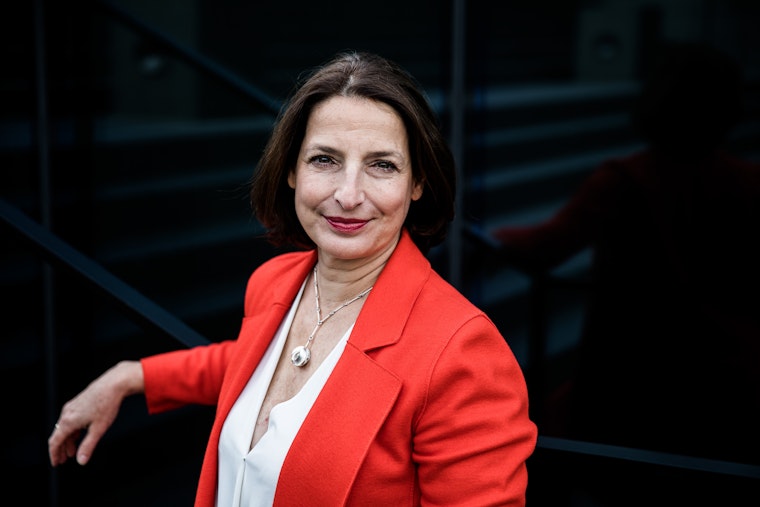
“Bliss it was to be alive / But to be young was very heaven!” So wrote William Wordsworth about the French revolution. Two hundred years later, Viktor Orban and Zsuzsanna Szelenyi were perhaps the modern incarnations of that spirit. Politics had utterly consumed them for more than a year. But now, in the summer of 1989, they were off on new adventures. Zsuzsanna Szelenyi, aged 23, was going to study psychology in San Diego, California; meanwhile, the Soros Foundation (as it was then called) had awarded her friend Viktor Orban a scholarship to go to Oxford. Then, on November 9, 1989, just as they were settling in, the Berlin Wall came down.
Now, says Szelenyi, it was clear that the end of Communism was “unstoppable.” But watching this drama playing out on television while she was in far-away California was, she says, one of the most frustrating moments of her life. Within weeks, Szelenyi and Orban had abandoned their studies and were back in the thick of it.
Szelenyi’s parents and grandparents had been involved in Hungary’s 1956 uprising, and so she grew up in a fiercely anti-Communist family that regularly tuned in to the United States-funded Radio Free Europe to keep track of what was going on. In March 1988, Szelenyi, then studying in Budapest, read in the papers that five students had been warned by the police against starting an anti-government organization. A few days later, she had become a member herself. Communism was withering, and she did not feel frightened. Soon afterward, she became one of the nine-member collective leadership of Fidesz (the Alliance of Young Democrats), in which Orban was emerging as its informal chief.
Back from California, Szelenyi returned to her home in Veszprem to campaign for the first free election to be held in March 1990. Her team had little money, so they painted posters and campaigned with drums. “It was an incredibly happy period! It changed my life completely,” says Szelenyi, as her children wander in and out of the living room where we are sitting and a gentle breeze parts the curtains. The room is piled high with books; from the window, you can see the rolling green hills of the outskirts of Budapest, Hungary’s capital.
Almost everyone in the new parliament was learning by the day. But, increasingly, it was clear that, for Orban, politics was more than just a means for remaking Hungary into a Western European-style democracy. “Orban thought money is politics and money is power and power is money. He began to use party finances in a non-transparent way, which we learned from the news, and that created huge distrust.”
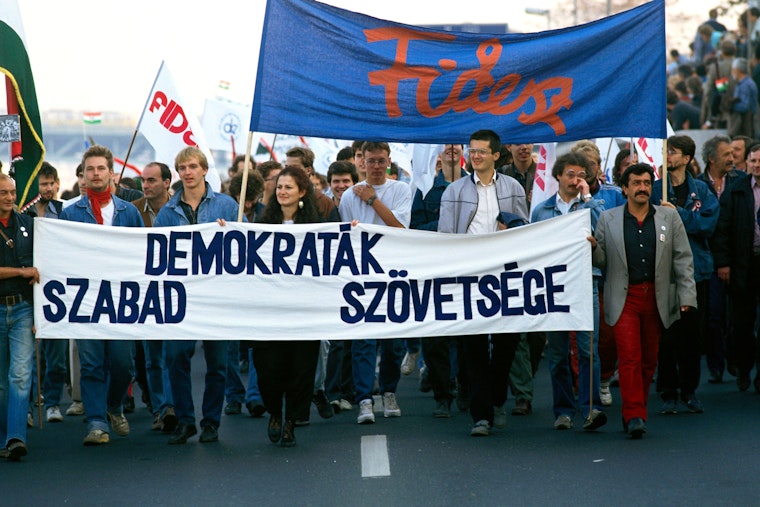
By 1993, the blissful dawn was over, at least for Szelenyi. She quit Fidesz, and Orban shifted it to the right. In 1989, everyone in the opposition wanted the same things, recalls Szelenyi. A few years later that was over. Political tensions that dated from well before World War II were returning, including the old division between Western-oriented, urban, pluralistic liberals and Hungarians rooted in a more rural and nationalistic tradition.
Szelenyi worked for 15 years for the Council of Europe and then returned to the Hungarian parliament for four years in 2014. Now she has a new project. The world has changed, she says, and she is planning a school to teach leadership skills to a new generation of political and civil society activists. Today, she says, she is more of a realist than she was in 1989. But she knows the value of civil society. After all, she remarks, Communism in Hungary fell thanks in part to civil society organizations. (They included environmentalist groups and the Soros Foundation, which helped by providing computers and photocopiers that made it easier for activists to spread their messages.)
Orban understands this very well, she says, which is precisely why he is trying to squeeze the space for political expression today. An open society is an “enemy or rival for Orban, and that is why he will never let it go. This is why Central European University had to leave Hungary. Not because it is a university, but because Orban regards it as a cradle of free thought.”
Orban, and Hungary’s current slide to autocracy will not last forever, Szelenyi says. And that is why she wants to prepare the next generation. Will they want to put Hungary back on the European track of development, or “will they be satisfied with the semi-democratic, autocratic, peripheral world where Hungary is heading at the moment?” The question, she says, has not yet been answered.
Anna Lengyel
“You can imagine coming of age at the same time as having your country become a free democracy from a dictatorship occupied by a foreign army. The euphoria, I don’t know if you can have anything bigger than that.”
— Anna Lengyel, Founder and Director, PanoDramaIn 1989, Anna Lengyel was 20 years old.
